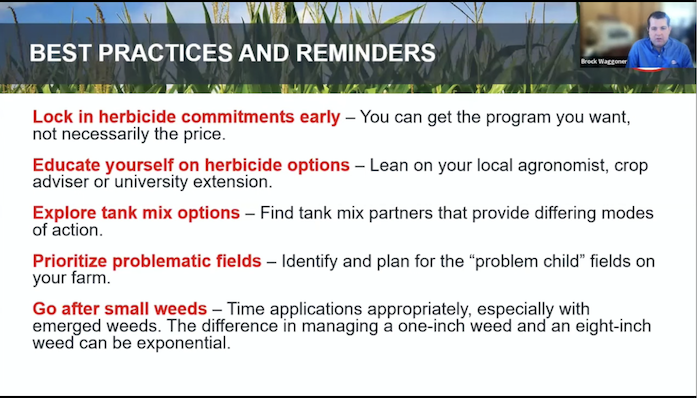Setting the foundation for a productive and profitable growing season starts with a clean field. In today’s world, that could mean using a combination of traditional and novel products to provide effective weed control.
Brock Waggoner, technical agronomist at Helm, says there is currently a divide between synthetic and biological products in the U.S.
“Since the 1950s, we've had a lot of synthetic solutions with herbicides, insecticides, fungicides — all of those things we have come to depend on in agriculture today,” Waggoner says. “What we're starting to realize is how biologicals influence how we utilize synthetic solutions. When we put the two together, we’re bridging the gap.”
He shared 8 best practices and reminders for starting clean and staying clean using products that bridge the gap in this No-Till Farmer webinar.
- Lock in herbicide commitments early.
“We're still seeing reductions in several key active ingredients, either being available or not being able to be produced in a timely manner. The earlier you can lock those in, the better you can plan.”
- Educate yourself on herbicide options.
“There are new products coming into the marketplace. Educate yourself on them because there's a lot of opportunities out there to fill in those gaps as we have to continue to have some supply issues.”
- Explore tank mix options.
“Find tank mix partners that provide different modes of action.”
- Prioritize problematic fields.
“We sometimes get problematic fields because they’re the farthest away from the farm and the last ones we start on. If you start early on those, you’re able to get ahead of the weeds.”
- Go after small weeds.
“Time applications appropriately, especially with emerged weeds. Make sure they’re smaller than a beer can or a Coke can, which are typically 4 inches.”
- Evaluate adjuvant options.
“Look at what your adjustment options are and what the label says. Adjuvants help make sure that the product gets to where it works the best and that herbicide, fungicide or insecticide is able to do its job.”
- Take the pressure off postemergence.
“Options like Reviton and paraquat can really help you start the season clean because they have a very non-selective nature and are able to work quite fast. That's really what helps you start clean and stay clean.”
- Manage the details.
“Control the controllables. It's amazing how many small things add up to big returns. Make sure sprayer nozzles are calibrated correctly. Use the correct boom height. Watch your application speed, and apply during the day in the right conditions to avoid dew.”
Related Content
Setting a Foundation — Shaping the Soil for Robust Plant Health and Efficiency [Webinar]







Post a comment
Report Abusive Comment